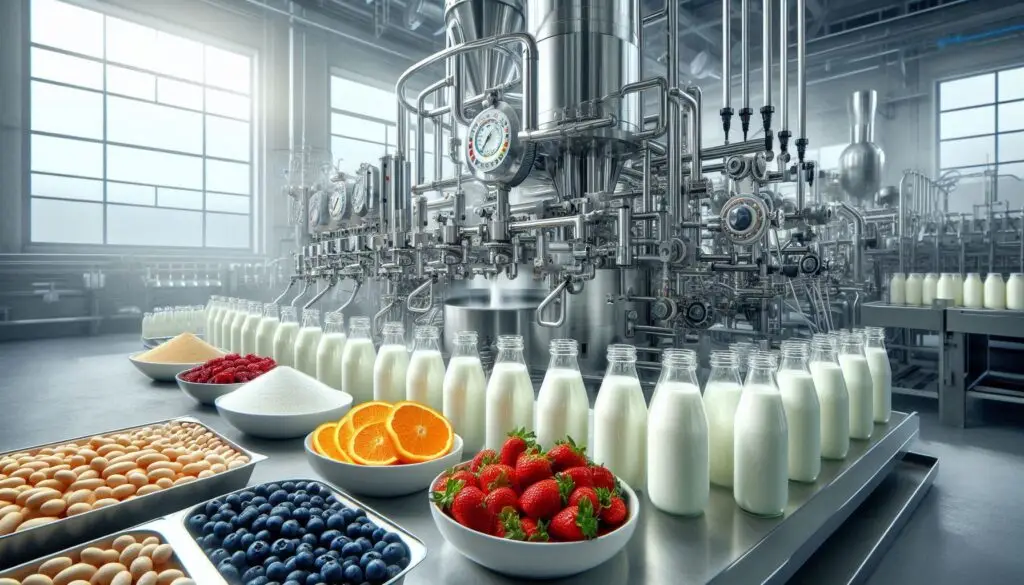Effects of Processing on Milk

Understanding Milk Processing
Milk processing ensures safety, enhances texture, and preserves nutrients. Various techniques alter milk’s properties, making it suitable for consumption and dairy product manufacturing. This article explores how processing affects milk bacteriologically, physically, chemically, and nutritionally.
Bacteriological Effects of Milk Processing
Pasteurization and Sterilization Enhance Safety
Milk contains natural bacteria, some of which can be harmful. Pasteurization heats milk to a specific temperature to eliminate pathogens, ensuring safety. According to the CDC, pasteurization reduces the risk of infections from harmful bacteria like Salmonella and Listeria.
Sterilization, a more intense process, extends shelf life by completely killing microorganisms. However, it may slightly alter taste and nutritional properties.
Fermentation Controls Microbial Growth
Adding beneficial bacteria through fermentation produces yogurt, cheese, and other cultured dairy products. These bacteria control microbial activity, enhancing shelf life and digestibility. Research from the National Dairy Council confirms that probiotics in fermented dairy improve gut health.
Cold Storage Preserves Quality
Refrigeration slows bacterial growth, preserving freshness. Rapid cooling right after milking is crucial. The FAO states that maintaining milk at 4°C extends its usability without preservatives.
Physical Effects of Milk Processing
Homogenization Prevents Cream Separation
Homogenization breaks fat globules into smaller sizes, preventing them from rising to the top. This process improves consistency and creates a smoother texture. Dairy Research Institute highlights that homogenized milk is easier to digest due to uniform fat distribution.
Heat Treatment Alters Viscosity
When milk undergoes heat processing, its viscosity changes. This is essential for producing yogurt and cheese. High-heat treatment denatures proteins, helping in gel formation and better texture.
Churning Transforms Cream into Butter
Mechanical agitation, known as churning, converts liquid cream into solid butter by separating fat from the liquid. The butter-making process relies on physical force rather than chemical reactions.
Chemical Effects of Milk Processing
Protein Alteration During Pasteurization
Heat processing slightly modifies milk proteins, affecting their functionality. This can influence milk’s ability to form foam or curds during cheese production. The Journal of Dairy Science explains that pasteurization reduces certain enzyme activities while maintaining essential proteins.
pH Adjustments in Cheese-Making
Lowering the pH helps in curd formation, a key step in cheese-making. The addition of acids like lactic acid changes protein interactions, affecting cheese texture and moisture content.
Enzymatic Reactions in Dairy Products
Certain enzymes, such as rennet, play a role in cheese production by coagulating proteins. These enzymatic changes impact taste, texture, and digestibility.
Nutritional Effects of Milk Processing
Vitamin Loss During Heat Treatment
High temperatures may degrade sensitive vitamins like B12 and C. However, milk remains a rich nutrient source despite minimal losses. Fortification compensates for any lost nutrients.
Lactose Transformation Improves Digestibility
Fermentation converts lactose into lactic acid, benefiting lactose-intolerant individuals. This process produces probiotics, supporting gut health. Harvard Medical School emphasizes the role of probiotics in digestion.
Fortification Enhances Nutrient Content
To ensure complete nutrition, milk is often fortified with vitamins D and A. These additions help address common deficiencies, especially in populations with limited sun exposure.
Conclusion
Milk processing significantly affects its safety, texture, chemical composition, and nutritional value. While some nutrients may be lost, the overall benefits of processing outweigh the drawbacks. By ensuring microbial safety, improving texture, and enhancing digestibility, these processes make dairy products more accessible and beneficial to consumers.
For more pearls of Vets Wisdom:
Estimating Sires: Progeny Testing and Threshold Models




Responses